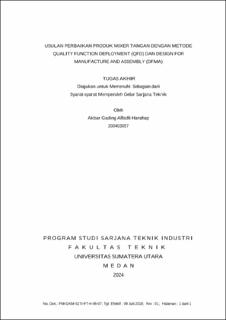Usulan Perbaikan Produk Mixer Tangan dengan Metode Quality Function Deployment (QFD) dan Design For Manufacture and Assembly (DFMA)
Proposed Improvement of Hand Mixer Products with Quality Function Deployment (QFD) and Design for Manufacture and Assembly (DFMA) Method

Date
2024Author
Harahap, Akbar Gading Alfadli
Advisor(s)
Ginting, Rosnani
Metadata
Show full item recordAbstract
The necessity of electronic devices has become essential for many individuals. Every household has implemented them in their usage with various functions and forms, leading to the emergence of issues, one of which is the mixer, a device with specific usage in the culinary field for mixing dough. One of the problems is the excessive use of bolt connections for the connection of 2 components which getting loose because of the high vibration from the mixer. Therefore, it is necessary to improve the product design of the mixer using the Quality Function Deployment Method Phase I and Phase II and further improve it in the subsequent method of Design for Manufacture and Assembly to determine product design improvements for design efficiency and assembly cost savings. The aim of this research is to identify the priority of technical characteristics and critical parts in the mixer product using the QFD Method Phase I and QFD Phase II, as well as to identify the comparison between the actual design and the proposed design of the mixer product after improvement using the Design for Manufacture and Assembly method. The improvement to the proposed mixer design is by using a snap-fit approach, which integrates parts to connect between components, namely the body cover, and eliminates bolt connections. Based on the comparison between the actual design and the proposed design, the results show a decrease in assembly time to 17.19 seconds and a decrease in the number of constituent components by 2 units. The assembly efficiency of the proposed design increased by 0.56%. In addition, there was a cost saving in assembly of Rp17.69.
Collections
- Undergraduate Theses [1479]
